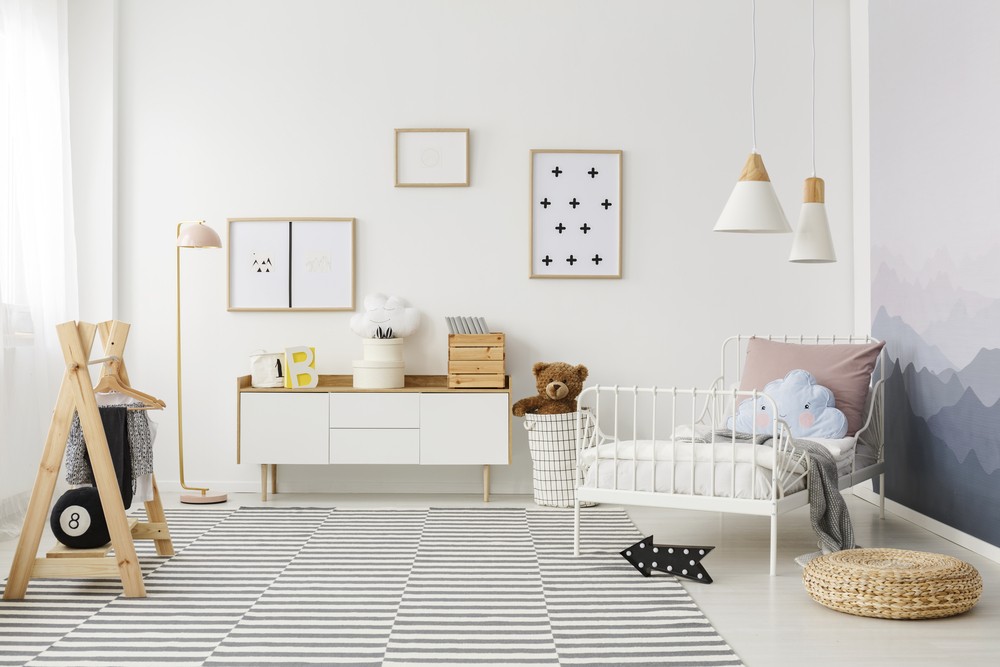As a BetterHelp affiliate, we receive compensation from BetterHelp if you purchase products or services through the links provided
Getting your 2-year-old to sleep in their bed all night can be a daunting task for many parents. As toddlers grow and develop, they test boundaries and assert their independence. While essential for their growth, this natural process can sometimes lead to bedtime battles and sleepless nights. But don’t worry – with patience, consistency, and the right strategies, you can help your little one transition to sleep in their bed all night.
To begin with, it’s crucial to understand your toddler’s sleep patterns, needs, and potential challenges, such as separation anxiety or night terrors. By gaining a deeper understanding of these factors, you will be better equipped to create a nurturing sleep environment and a consistent bedtime routine that promotes better sleep habits for your child. Additionally, it’s essential to consider different sleep training techniques to identify the best method for your family.
Key Takeaways
- Understand your toddler’s sleep patterns and needs to create a nurturing sleep environment.
- Establish a consistent bedtime routine to promote healthy sleep habits for your child.
- Explore different sleep training techniques to fit your family’s situation best.
 Understanding Toddler Sleep
Understanding Toddler Sleep
The Importance of Sleep in Toddlers
Sleep is crucial for your toddler’s development, both mentally and physically. It’s during sleep that your child’s body repairs itself and grows. Moreover, adequate rest promotes healthy brain function, memory, and emotional well-being. A consistent sleep schedule can help regulate your toddler’s circadian rhythm, which is their internal sleep-wake cycle.
To ensure your 2-year-old gets the best possible sleep, follow these tips:
- Keep a consistent bedtime and wake-up time.
- Create a relaxing bedtime routine.
- Make their bedroom conducive to sleep (dark, calm, and quiet).
Common Toddler Sleep Problems
Various sleep issues may arise in toddlers, making it challenging to sleep through the night in their own bed. Some common problems include:
- Night terrors: These frightening episodes can cause your child to cry, scream, or thrash around in their sleep. To help prevent night terrors, maintain a regular sleep schedule and provide a calming bedtime routine.
- Nightmares: Bad dreams can leave your toddler feeling scared and unable to return to sleep. Encourage open communication about their fears and offer reassurance. A comforting nightlight can also make their room feel safer.
- Waking up at night: Toddlers may wake up crying or needing reassurance during the night. To help your child learn to self-soothe, give them a comfort item, like a favorite stuffed animal or a small blanket.
In conclusion, understanding toddler sleep and addressing common sleep problems can empower you to establish healthy sleep habits for your child. This will ultimately help your 2-year-old transition to sleeping in their bed all night. Consistency is vital, so stick to a routine and always be patient and supportive.
Creating a Consistent Bedtime Routine
Components of an Effective Bedtime Routine
To establish a solid bedtime routine for your 2-year-old, including specific activities that signal bedtime is approaching is essential. Some effective components for a bedtime routine may include:
- Bath time: A warm, calming bath helps your child relax and signifies that it’s time to wind down for the night.
- Pajamas: Changing into comfortable, clean pajamas can become a nightly ritual your child associates with sleep.
- Reading: Choose a few favorite books to read together, creating a peaceful, quiet environment before bed.
- White noise: Soft background noise, like a fan or white noise machine, can block out distractions and help your child fall asleep more easily.
Remember to keep these activities consistent to form a predictable routine your child can rely on each night.
Maintaining Consistency in Sleep Schedule
Consistency is key in helping your child sleep through the night in their bed. Establishing a consistent bedtime and wake-up time ensures your child gets the necessary amount of sleep. Avoid bright screens and blue light exposure close to bedtime, as this can disrupt your child’s natural sleep patterns. Stick to the schedule as much as possible, even on weekends, to maintain good sleep habits.
Key takeaway: Aim for a consistent bedtime and wake-up time for your child to promote healthy sleep patterns.
 The Role of Active Play and Naps in Bedtime Routine
The Role of Active Play and Naps in Bedtime Routine
Incorporating active play during the day helps your 2-year-old expend energy, which can help improve nighttime sleep. Just be cautious not to schedule rigorous activities too close to bedtime, as they may become too stimulated to settle down quickly.
Naps also play a vital role in your child’s sleep routine. Afternoon or daytime naps help to refresh and recharge your little one, aiding in better nighttime sleep. However, finding the right balance is crucial – too many naps or napping too late in the day can interfere with their bedtime. Keep naps consistent in time and duration, and avoid napping too close to bedtime.
Key takeaway: Encourage active play during the day and maintain consistent napping habits to support your child’s bedtime routine and overall sleep quality.
Tackling Separation Anxiety and Night Terrors
Pediatrician’s Advice on Night Terrors
Your pediatrician can provide valuable guidance on handling night terrors. They might suggest:
- Establishing a consistent bedtime routine to help your child feel secure.
- Monitoring your child’s sleep environment for any triggers, such as excessive noise or an uncomfortable temperature.
- Offering reassurance during a night terror but avoiding fully waking them up.
- Consult a sleep specialist if your child’s night terrors don’t improve or become more frequent or intense.
Methods to Ease Separation Anxiety at Night
If your child is experiencing separation anxiety, try these strategies to ease their fears and help them sleep:
- Create a soothing bedtime routine to help your child wind down and feel comforted.
- Make your child’s bedroom a cozy and inviting space with familiar bedding, soft lighting, and comforting objects like stuffed animals.
- Practice “goodbye” rituals during the day to build confidence in your child’s ability to handle separations.
- When it’s time to sleep, reassure your child that you’re nearby and will check on them throughout the night.
- Offer positive reinforcement and praise for successful nights spent in their bed.
By proactively addressing separation anxiety and night terrors, you can help your child develop healthy sleep habits and feel more secure in their own bed. Remember, patience and consistency are essential in this process.
 Transitioning to the ‘Big Kid’ Bed
Transitioning to the ‘Big Kid’ Bed
Steps in Introducing the Toddler Bed
It’s essential to make the transition to a toddler bed as smooth as possible for your little one. Start by introducing the big kid bed step by step. Follow these guidelines:
- Introduce the idea: Talk to your toddler about getting a new bed for big kids. Show them pictures of toddler beds or take them shopping to choose a bed they like.
- Set up the bed: Create a sense of ownership by involving your toddler in setting up their new bed. Let them help choose sheets and other bedding.
- Test it out during naps: Encourage your toddler to nap in the new bed. This will help them become familiar with and comfortable with sleeping in it.
- Gradual transition: Spend a few nights with your child in their new bed and progressively decrease your presence until they can sleep independently.
Making the Child’s Room Comfortable
A comfortable bedroom environment can make a significant difference in helping your toddler feel secure and sleep better. Consider these tips to make your child’s room more inviting:
- Choosing the right bedding: Ensure the bedding is cozy and age-appropriate. Involve your toddler in selecting bedding featuring their favorite colors or characters.
- Adding a night light: A soft light can offer your toddler a sense of security and comfort, especially if they are afraid of the dark.
- Keeping the room clutter-free: A tidy room with fewer distractions can help your toddler focus on sleep. Designate a designated space for toys and organize the room regularly.
- Maintaining a consistent temperature: A cooler room aids in better sleep. Aim for a temperature between 65-72 degrees Fahrenheit (18-22 degrees Celsius).
Reward System and Victory Celebration
Positive reinforcement can encourage your toddler to embrace the new sleeping arrangement. Implement a reward system to acknowledge your child’s efforts and celebrate their progress:
- Sticker chart: Create a fun sticker chart to track your child’s successful nights of sleeping in their big kid bed. Each morning they wake up in their bed, they can add a sticker to the chart.
- Small rewards: Offer small rewards, such as extra playtime or a special treat, after reaching a certain number of nights sleeping in the new bed.
- Praise: Regularly praise your toddler for their achievements and remind them how proud you are of their progress. Give them a high-five or a hug to celebrate their victories.
- Victory celebration: Plan a special celebration once your toddler has consistently slept in their bed. This could be a family movie night, a fun day outing, or a simple at-home party.
By incorporating these strategies, you’ll provide your toddler a positive and supportive environment as they transition to their big kid bed.
Potential Sleep Training Techniques
Understanding Sleep Training
Sleep training is an essential process for teaching your 2-year-old to sleep independently. Your goal is to establish healthy sleep habits and ensure your child falls asleep easily, sleeps soundly, and wakes up refreshed. Consult with your pediatrician to ensure your child is developmentally ready for sleep training. Consistency and timing are crucial to success, so be sure to:
- Develop a bedtime routine: A consistent routine, like reading a book, taking a warm bath, or singing a lullaby, can signal bedtime is near.
- Create a conducive sleep environment: Ensure your child’s room is cool, dark, and quiet to promote relaxation.
‘Cry It Out’ Method and Co-Sleeping
The ‘Cry It Out’ method usually involves letting your child cry for a predetermined time before providing comfort. Remember to:
- Offer reassurance periodically: Provide brief but comforting words and gentle touches when checking on your child.
- Gradually increase the intervals: Begin with shorter intervals and work your way up, allowing longer times between check-ins.
If you prefer co-sleeping with your child, consider transitioning them to their bed for a portion of the night. Start with a family bed or crib in the same room, then move it further away until they’re comfortable sleeping in their bed.
Regulating Family Stress and Maintaining Partner’s Role
Maintaining a positive atmosphere for your child during sleep training is critical. Manage stress by:
- Creating a supportive environment: Communicate openly with your partner about your feelings and goals for sleep training.
- Sharing responsibilities: Assign roles for each parent, such as taking turns soothing the child or handling nighttime disruptions.
On the Use of Sleep Aids
Before using sleep aids, consult with your pediatrician. They might recommend melatonin supplements if your child has difficulty producing the hormone naturally. However, relying on sleep aids should not be your end goal. Instead, focus on establishing healthy, lasting routines.
Conclusion
Transitioning a 2-year-old to sleeping in their own bed all night can be challenging for both the child and the family. However, with consistency and patience, it is achievable. One key tip is establishing a bedtime routine that helps your child wind down for the evening, signaling that it is time for sleep.
- Make sure their room is cozy and welcoming.
- Use bedtime stories and calming activities as part of the routine.
- Reinforce the idea that their bed is a safe place to sleep.
Remember that consistency is crucial in helping your child feel secure and confident in their ability to sleep in their bed all night. Stick to the same time and routine each night and avoid disruptions.
- Be patient and prepared for some setbacks.
- Offer reassurance and comfort if they wake up during the night.
- Praise and reward their efforts in the morning.
In conclusion, successfully helping your 2-year-old sleep in their bed all night comes down to ensuring a comfortable environment, establishing a consistent bedtime routine, and offering lots of support and encouragement. Once these elements are in place, your family will reap the benefits of a well-rested and content child.
Frequently Asked Questions

How can I transition my toddler from co-sleeping to their own bed?
Start by establishing a consistent bedtime routine to make your toddler feel secure. Gradually introduce the idea of their bed by spending time during the day in their room, playing or reading stories. You can initially move a mattress or sleep beside their bed for a few nights as they adjust. After some time, retreat to a chair by the door and finally out of the room.
Key takeaway: Gradual transitions and consistent routines help toddlers adjust to sleeping in their bed.
What strategies can help a 2 year old stay in bed all night?
- Encourage a feeling of security with a favorite stuffed toy or comfort item.
- Use a nightlight to create a soft glow in their room.
- Keep a consistent bedtime and wake-up time.
- Offer praise and positive reinforcement when they successfully sleep in their bed.
Key takeaway: Create a comfortable environment and develop a consistent bedtime routine to help your 2-year-old stay in bed all night.
How do I handle a toddler who refuses to sleep alone?
Be firm but compassionate. Acknowledge their feelings and calmly explain that it’s time to sleep independently. Offer comfort items like a special blanket or stuffed toy, and provide white noise or soothing music to help them relax. If they continue to resist, consider implementing a reward system for successful nights spent in their own bed.
Key takeaway: Validate their feelings, be consistent, and use comfort items or rewards to encourage independent sleep.
What are some tips for establishing a bedtime routine for my 2-year-old?
- Plan a consistent bedtime and wake-up time.
- Engage in calming activities, like a warm bath or reading stories.
- Limit screen time and avoid stimulating activities before bed.
- Create a cozy sleep environment with soft lighting and comfortable bedding.
Key takeaway: Structure and comforting pre-sleep activities can create an effective bedtime routine for your 2-year-old.
How do I ensure my toddler feels secure in their own bed?
Provide a familiar and comforting sleep environment using items such as blankets, pillows, and stuffed animals they love. A nightlight with a calm glow can also make their room more inviting. You can invest time in their room with activities like reading books to help them associate their bed with feeling safe and relaxed.
Key takeaway: Use familiar comforts and spend time together in their room to help your toddler feel secure in their own bed.
How can I address a 3-year-old’s nighttime fears to promote independent sleep?
- Acknowledge and validate their fears.
- Encourage open communication during the day about any concerns.
- Create a calm, safe sleep environment with soft lighting and comfort items.
- Consider using a “special spray” or a “monster-repelling” toy as a fun way to ease their fears.
Key takeaway: Addressing your child’s fears with understanding and creative solutions can promote a sense of security and encourage independent sleep.
- 7 Ideas to Help You Relax and Unwind on a Family Vacation - April 27, 2025
- How Having Cybersecurity Protection Helps You Relax - April 25, 2025
- 8 Reasons Why Spending Time Outside Calms You Down - April 25, 2025
This site contains affiliate links to products. We will receive a commission for purchases made through these links.


 Understanding Toddler Sleep
Understanding Toddler Sleep The Role of Active Play and Naps in Bedtime Routine
The Role of Active Play and Naps in Bedtime Routine Transitioning to the ‘Big Kid’ Bed
Transitioning to the ‘Big Kid’ Bed
